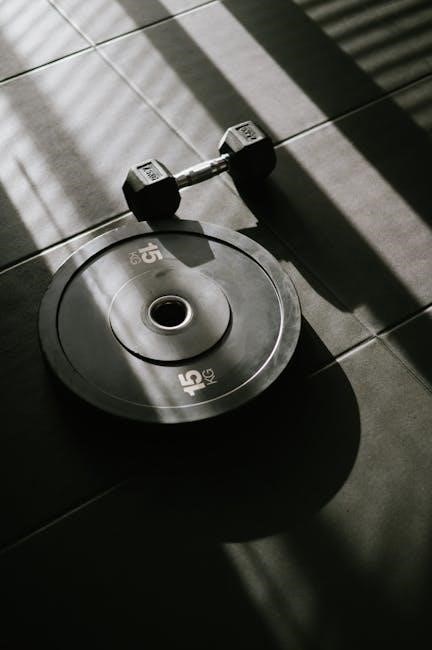resistance band workout pdf
Resistance band workouts are a versatile and effective way to build strength, offering portability and affordability. They are ideal for home, travel, or gym use, catering to all fitness levels. Popular for full-body engagement, they are widely available as downloadable PDF guides, providing structured routines for users seeking convenience and efficiency in their training.
1.1 What is a Resistance Band Workout?
A resistance band workout is a form of strength training that uses elastic bands to create tension, engaging muscles through both concentric and eccentric movements. These workouts are highly adaptable, catering to various fitness levels, from beginners to advanced athletes. Resistance bands are lightweight, portable, and cost-effective, making them ideal for home, travel, or gym use. They offer a wide range of exercises targeting different muscle groups, including the chest, back, legs, shoulders, arms, and core. Unlike traditional weights, resistance bands provide continuous tension throughout exercises, enhancing muscle engagement and promoting functional strength. Their versatility allows for full-body workouts, isolation exercises, or even combination movements. Additionally, resistance bands are widely available in downloadable PDF guides, offering structured routines and exercise charts for users seeking convenience and efficiency in their training. This accessibility makes them a popular choice for those looking to improve strength, flexibility, and overall fitness without bulky equipment.
1.2 Importance of a Resistance Band Workout Plan
A well-structured resistance band workout plan is essential for achieving consistent progress and maximizing the effectiveness of training. It ensures a balanced approach, targeting all major muscle groups to build strength, improve flexibility, and enhance overall fitness. A planned routine helps maintain consistency, which is crucial for muscle development and avoiding plateaus. By organizing exercises into sets, reps, and frequencies, it allows for progressive overload, gradually increasing resistance to challenge muscles further. This structured approach also minimizes the risk of overtraining or neglecting specific areas, promoting a holistic fitness journey. Additionally, having a clear plan boosts motivation and accountability, helping individuals stay committed to their goals. With numerous downloadable PDF guides available, creating a personalized resistance band workout plan is more accessible than ever, making it easier for anyone to adopt a disciplined and effective training regimen from the comfort of their home.

Benefits of Resistance Band Workouts
Resistance bands offer exceptional portability, cost-effectiveness, and versatility, making them ideal for full-body workouts anywhere. They engage multiple muscle groups simultaneously, enhancing strength and flexibility while being lightweight and easy to store, perfect for home or travel use.
2.1 Portability and Convenience
Resistance bands are incredibly portable, making them ideal for workouts at home, in the gym, or while traveling. Their lightweight design allows for easy storage in small spaces, ensuring they can accompany you wherever you go. Unlike bulky gym equipment, resistance bands take up minimal room, making them a practical choice for anyone with limited space. Additionally, their convenience extends to their versatility, as they can be used in various settings, from outdoor parks to hotel rooms. Many resistance band workout plans are available as downloadable PDFs, further enhancing their accessibility. This portability ensures consistency in your fitness routine, regardless of your location; Their ease of use and transportability make resistance bands a favorite among fitness enthusiasts who value flexibility and convenience in their training. Whether you’re a traveler or someone who prefers home workouts, resistance bands offer an unmatched level of portability and ease of use.
2.2 Cost-Effectiveness
Resistance bands are an economical choice for strength training, offering a budget-friendly alternative to costly gym memberships or heavy equipment. Priced significantly lower than traditional workout gear, they provide exceptional value for their durability and versatility. A single set of resistance bands can be used for a wide variety of exercises, targeting multiple muscle groups without the need for additional purchases. Their cost-effectiveness is further enhanced by their long lifespan, as they are constructed from durable materials that withstand regular use. Additionally, free downloadable PDF guides, such as the resistance band workout PDF, eliminate the need for expensive workout plans. This affordability makes resistance bands accessible to individuals of all income levels, ensuring that everyone can achieve their fitness goals without financial strain. Their low cost, combined with their effectiveness, makes resistance bands a practical and economical option for anyone seeking to improve their strength and fitness.
2.3 Full-Body Engagement
Resistance band workouts are exceptional for engaging multiple muscle groups simultaneously, making them ideal for full-body exercises. Unlike traditional weights, resistance bands allow for dynamic movements that target both primary and secondary muscles, enhancing functional strength and coordination. For instance, exercises like chest presses and rows work the chest, shoulders, and back, while squats and lunges engage the legs and core. This comprehensive engagement ensures a balanced workout, improving overall muscle development and flexibility. Additionally, resistance bands can be easily incorporated into compound movements, such as bent-over rows or shoulder presses, which activate several muscle groups at once. Their versatility enables users to design routines that target every major muscle group, from the arms and legs to the core and back, making them a standout choice for those seeking an efficient and effective full-body workout. This feature is particularly highlighted in the resistance band workout PDF, which provides detailed exercises for whole-body training.
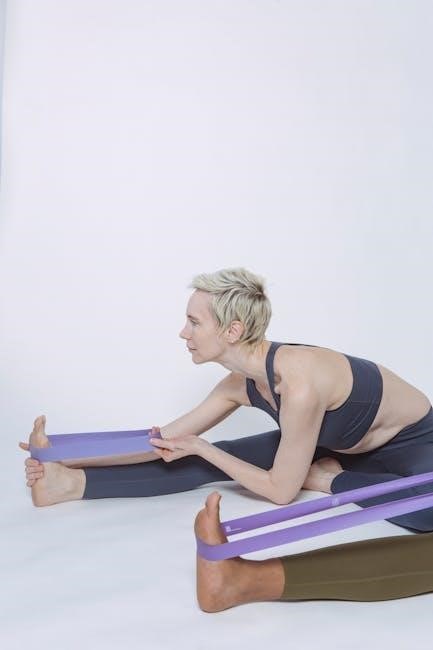
Types of Resistance Bands
Resistance bands come in various forms, including loop, tube, and fabric bands, each offering unique benefits. They are portable, durable, and suitable for all fitness levels, making them versatile for any workout routine.
3.1 Loop Bands
Loop bands are circular resistance bands that offer versatility and durability. They are ideal for both upper and lower body exercises, such as squats, chest presses, and rows. Their compact design makes them portable, perfect for home or travel workouts. Loop bands are available in various resistance levels, catering to different fitness goals. They are cost-effective and easy to store, making them a popular choice for full-body workouts. Many downloadable PDF guides include detailed routines using loop bands, ensuring users can maximize their training. Their simplicity and effectiveness make them a must-have for anyone looking to enhance strength and flexibility without bulky equipment. Whether you’re a beginner or an advanced athlete, loop bands provide a challenging and efficient way to stay fit. They are also easy to incorporate into daily routines, offering a practical solution for consistent muscle engagement and growth.
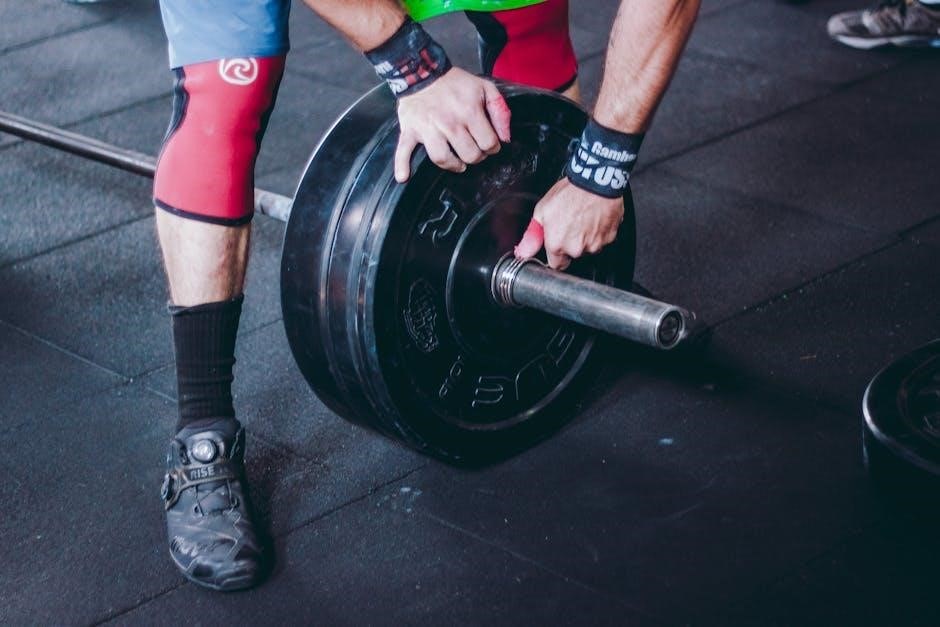
3.2 Tube Bands
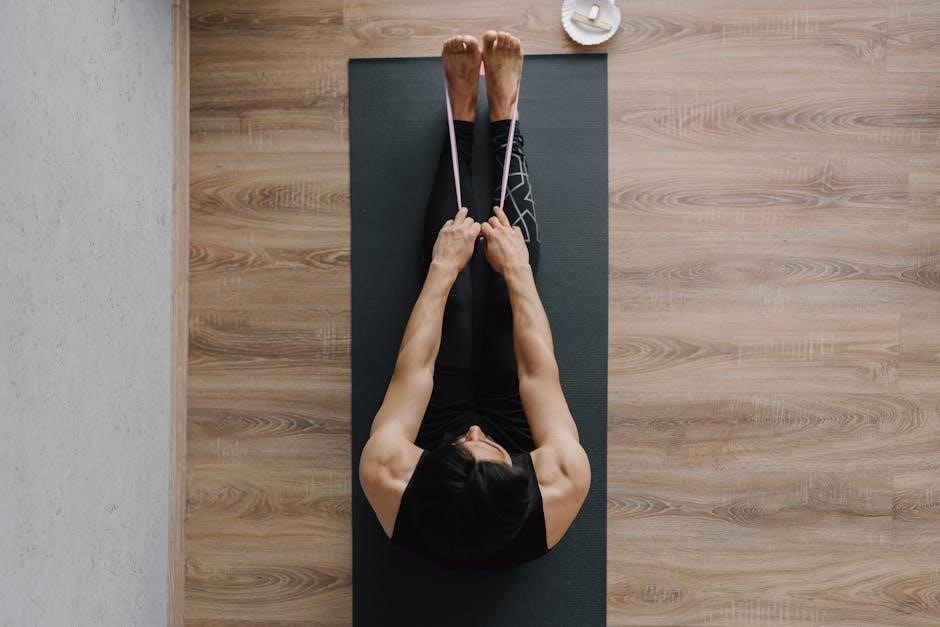
Tube bands are a popular choice for resistance training, known for their durability and versatility. They typically consist of a rubber tube with handles on both ends, allowing for a wide range of exercises. Unlike loop bands, tube bands provide a more traditional feel similar to dumbbells, making them ideal for exercises like bicep curls, chest presses, and shoulder presses. They are often used in full-body workout routines and are included in many downloadable PDF guides. Tube bands are available in various resistance levels, catering to different fitness goals. Their ergonomic handles offer a comfortable grip, reducing strain during workouts. They are also easy to store and transport, making them a great option for both home and gym use. Tube bands are highly effective for targeting specific muscle groups and can be combined with other exercises for a comprehensive workout. Their versatility and ease of use make them a favorite among fitness enthusiasts of all levels.

3.3 Fabric Resistance Bands
Fabric resistance bands are a modern and comfortable alternative to traditional rubber bands. Made from durable, breathable materials, they are designed to provide a soft, non-irritating surface against the skin. These bands are ideal for individuals who prefer a more gentle yet effective workout experience. Fabric resistance bands are often used in full-body routines and are included in many downloadable PDF guides. They are versatile and can be used for exercises like chest presses, rows, and leg curls. Their fabric construction reduces the risk of snapping and provides a consistent resistance level. Fabric bands are also easy to clean and maintain, making them a practical choice for home workouts. They are available in various resistance levels, catering to different fitness goals. Their comfort and durability make them a popular choice among fitness enthusiasts, especially for those who prioritize ease of use and long-lasting performance.

Best Resistance Band Exercises for a Full-Body Workout
Resistance bands offer versatile exercises for a full-body workout, targeting chest, back, legs, shoulders, and arms. Popular exercises include chest presses, rows, squats, and shoulder presses, ensuring comprehensive muscle engagement and strength building.
4.1 Chest Exercises
Chest exercises with resistance bands are effective for building strength and definition. A popular exercise is the chest press, where the band is anchored behind the back, and the ends are pressed forward. This mimics a dumbbell press, engaging the pectoralis muscles. Another essential exercise is the chest fly, where the band is held in both hands and arms are extended sideways, targeting the chest from different angles. For added intensity, the incline chest press can be performed by anchoring the band higher, emphasizing the upper chest. These exercises are versatile, allowing for adjustments in resistance by changing band tension or combinations. They are ideal for home workouts, providing a comprehensive chest routine without heavy equipment. Incorporating these exercises into a resistance band workout plan ensures a strong, balanced chest development, suitable for all fitness levels. Regular practice enhances muscle endurance and overall upper body strength effectively.
4.2 Back Exercises
Resistance band back exercises are excellent for strengthening the latissimus dorsi, rhomboids, and trapezius muscles. A fundamental exercise is the bent-over row, where the band is anchored at waist height, and the ends are pulled toward the torso, engaging the entire back. Another effective exercise is the seated row, performed by sitting on the floor with the band looped around a stable object, pulling the ends toward the chest. For targeting the upper back, the reverse fly is ideal, with the band held at shoulder height and arms extended sideways. These exercises improve posture, enhance muscle definition, and boost functional strength. They are easily customizable by adjusting band tension or incorporating variations like single-arm rows. Resistance band back exercises are versatile, requiring minimal equipment, and are perfect for home or travel workouts. Regular practice can lead to a stronger, more balanced back, essential for overall physical fitness and injury prevention.
4.3 Leg Exercises
Resistance band leg exercises are highly effective for building strength and definition in the quadriceps, hamstrings, glutes, and calves. One of the most popular exercises is the resisted squat, where the band is looped around the thighs, just above the knees, and the user performs a squat while maintaining tension. Another effective exercise is the donkey kick, which targets the glutes by looping the band around the ankles and performing a kicking motion while on all fours. For hamstrings, the hamstring curl is ideal, with the band anchored under the feet and the user curling the heels toward the glutes. These exercises are versatile, allowing for variations like single-leg movements to increase intensity. Resistance bands are particularly beneficial for leg training because they provide continuous tension, enhancing muscle engagement. Regular practice can improve balance, strength, and overall lower-body mobility, making them a great addition to any fitness routine.
4.4 Shoulder Exercises
Resistance band shoulder exercises are excellent for building strength, improving mobility, and enhancing posture. One of the most effective exercises is the lateral raise, where the band is looped under the feet, and the user holds the ends while lifting the arms out to the sides until they are shoulder-height. Another popular exercise is the front raise, performed similarly but with the arms lifted forward. For targeting the rear deltoids, the bent-over row is ideal, with the band anchored under the feet and the user pulling the ends toward the chest while bending at the waist. The overhead press is also a great option for building shoulder strength, using a heavier resistance band to press the arms upward. These exercises are versatile, allowing for variations in resistance levels and ranges of motion. Regular practice can improve shoulder stability, reduce injury risk, and enhance overall upper-body functionality.
4.5 Arm Exercises
Resistance band arm exercises are perfect for targeting the biceps, triceps, and forearms. A classic exercise is the bicep curl, where the band is looped under the feet, and the user holds the ends while curling the arms toward the shoulders. For triceps, the tricep extension is highly effective, involving the band looped behind the back and the arms extended overhead. Another variation is the overhead tricep extension, where the band is held overhead with both hands and lowered behind the head. To engage the forearms, the hammer curl can be performed by holding the band with palms facing each other and curling the arms. These exercises are easily modifiable by adjusting band tension or combining with other movements. Regular practice can improve arm strength, tone muscles, and enhance overall upper-body definition. Resistance bands make arm workouts accessible and efficient, suitable for both beginners and advanced fitness enthusiasts.
4.6 Core Exercises

Resistance band core exercises are excellent for building strength, stability, and balance. A popular exercise is the Pallof press, where the band is anchored and pressed away from the body to engage the obliques. The Russian twist is another effective movement, involving seated twists with the band held across the chest. For targeting the lower abs, the leg raise can be performed by looping the band around the feet and lifting the legs while lying down. The donkey kickback is also a great option, working the lower back and glutes by bending over and pulling the band apart. These exercises can be modified by changing the band’s tension or adding pulses for intensity. Regular core workouts with resistance bands improve posture, enhance athletic performance, and support overall stability. They are easy to incorporate into any fitness routine, making them a versatile choice for strengthening the core muscles effectively.
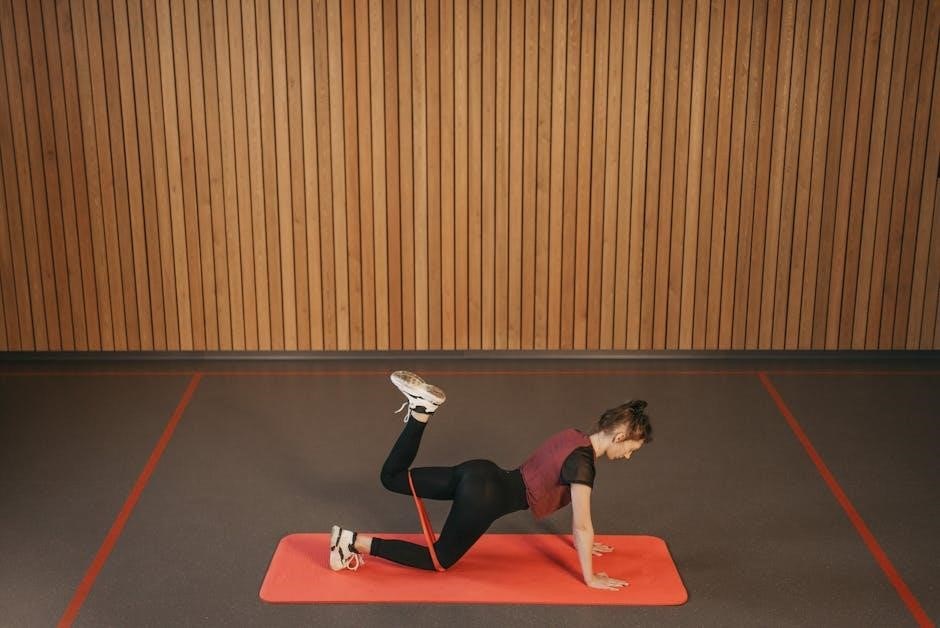
Creating a Resistance Band Workout Plan
A well-structured resistance band workout plan ensures balanced training. Set clear goals, define weekly schedules, and track progress. Focus on repetitions, sets, and gradual intensity increases for optimal results and muscle engagement.
5.1 Weekly Schedule and Frequency
Creating a consistent weekly schedule is crucial for maximizing the benefits of resistance band workouts. A typical plan involves 4-5 days of structured training, with 2-3 days of rest or recovery. Each session can target specific muscle groups, such as chest, back, legs, shoulders, and arms, ensuring a balanced approach. For beginners, starting with 3 days a week and gradually increasing frequency as fitness levels improve is recommended. It’s important to allow at least 48 hours of rest between sessions targeting the same muscle group to promote recovery and muscle growth. Consistency and progressive overload are key to achieving strength and conditioning goals. Sticking to a well-planned schedule helps maintain discipline and ensures steady progress over time.
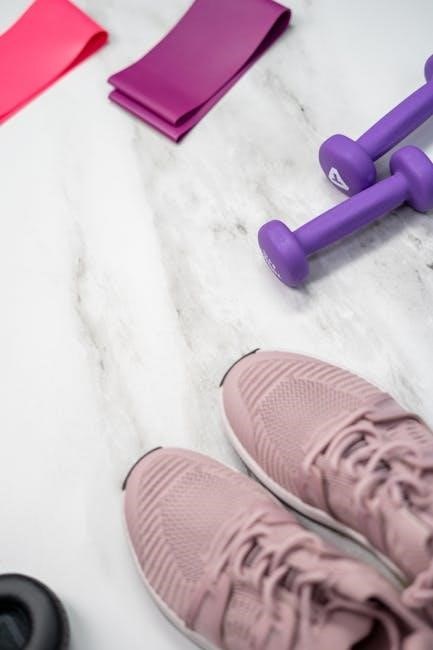
5.2 Repetitions and Sets
When designing a resistance band workout plan, determining the appropriate number of repetitions and sets is essential for achieving desired fitness goals. Typically, 3-4 sets per exercise, with 8-15 repetitions, are recommended to build strength and muscle endurance. For hypertrophy, higher repetitions (12-20) with lighter resistance can be effective, while lower reps (6-8) with higher resistance are ideal for building raw strength. Beginners may start with 2-3 sets of 10-12 reps to build a foundation. Progressively increasing the number of sets or reps as fitness improves ensures continued progress. Rest periods between sets should be 60-90 seconds for strength training and 30-60 seconds for endurance-focused workouts. Consistency in following the repetition and set structure helps maximize the effectiveness of the workout routine and promotes long-term muscle development. Adjustments can be made based on individual goals and fitness levels. This structured approach ensures a balanced and productive training regimen.
5.3 Progressive Overload
Progressive overload is a fundamental principle in resistance band training, involving gradual increases in resistance to challenge muscles and stimulate growth. This can be achieved by using thicker bands, layering multiple bands, or increasing the range of motion. For example, adding a second band or switching to a higher resistance level forces muscles to adapt. Additionally, increasing repetitions or sets over time enhances endurance and strength. Tracking progress through workout logs helps maintain consistency and ensures steady improvement. Incorporating variations in exercises, such as changing the angle or stance, also adds complexity. Over time, this method prevents plateaus and ensures continuous muscle development. Consistent application of progressive overload is key to achieving long-term fitness goals with resistance bands. By gradually increasing the challenge, users can maximize the effectiveness of their workout routines and enjoy sustained progress in strength and muscle tone. This approach keeps workouts engaging and results-oriented.
Incorporating Resistance Bands with Other Exercises
Resistance bands can enhance workouts by combining with bodyweight exercises, dumbbells, and other equipment. This integration boosts intensity and muscle engagement, offering a well-rounded fitness routine for strength and flexibility.
6.1 Combining with Bodyweight Exercises
Combining resistance bands with bodyweight exercises is a highly effective way to enhance your workout. By adding resistance to traditional exercises like push-ups, squats, and lunges, you can increase the intensity and challenge your muscles further. This hybrid approach allows for a full-body workout that targets strength, flexibility, and endurance. For example, using a resistance band during push-ups adds tension, engaging the chest and shoulders more deeply. Similarly, wrapping a band around your thighs during squats or lunges intensifies the workout for your legs and glutes. Even core exercises like planks can benefit from the added resistance of a band. This combination is portable, cost-effective, and customizable, making it ideal for individuals who prefer versatile and dynamic training. It also ensures continuous progression, as you can adjust the resistance level to match your fitness goals. This method is perfect for those seeking to maximize their workout efficiency without relying solely on weights or gym equipment.
6.2 Adding Dumbbell Exercises
Incorporating dumbbells into your resistance band workouts adds another dimension to your training, allowing for greater diversity and intensity. This combination enables you to target specific muscle groups with precision, blending the constant tension of bands with the controlled resistance of dumbbells. For instance, performing a chest press with a resistance band while holding dumbbells enhances both the push and pull phases, maximizing muscle engagement. Similarly, combining dumbbell squats with a band around your thighs intensifies the workout for your legs and glutes. This hybrid approach also allows for progressive overload, as you can gradually increase the weight of the dumbbells or the resistance level of the bands. It’s an excellent way to build lean muscle, improve strength, and enhance functional fitness. Plus, it keeps workouts engaging and challenging, preventing plateaus and ensuring continuous progress. This method is ideal for those who have access to both equipment types and seek a comprehensive training routine.

